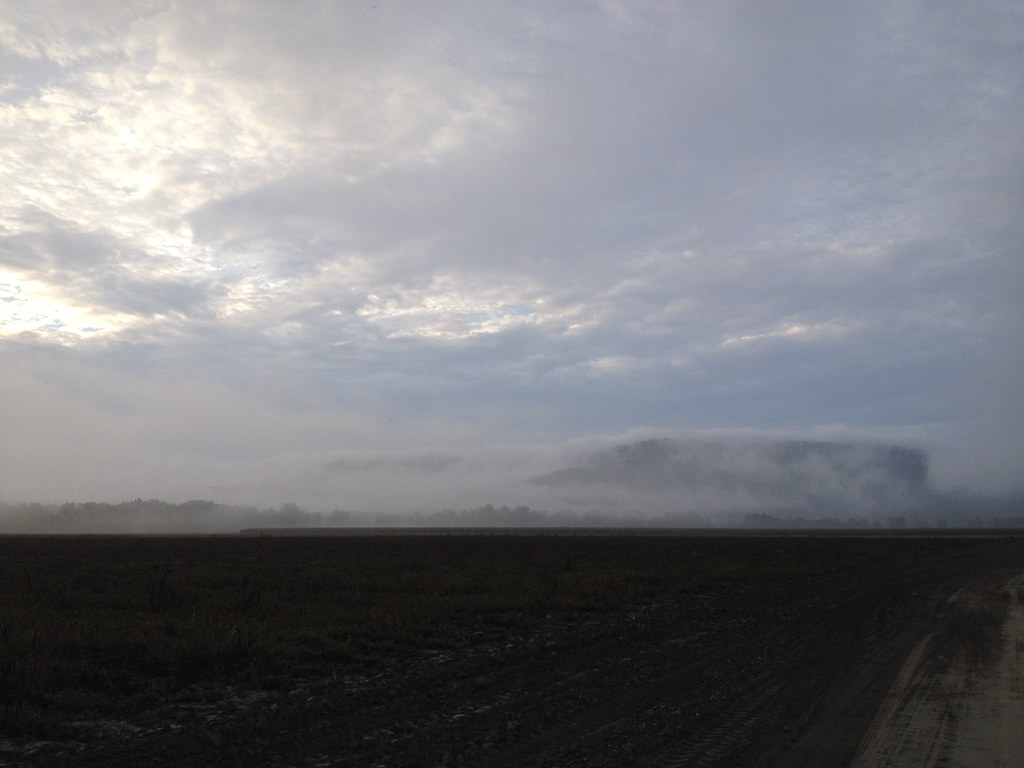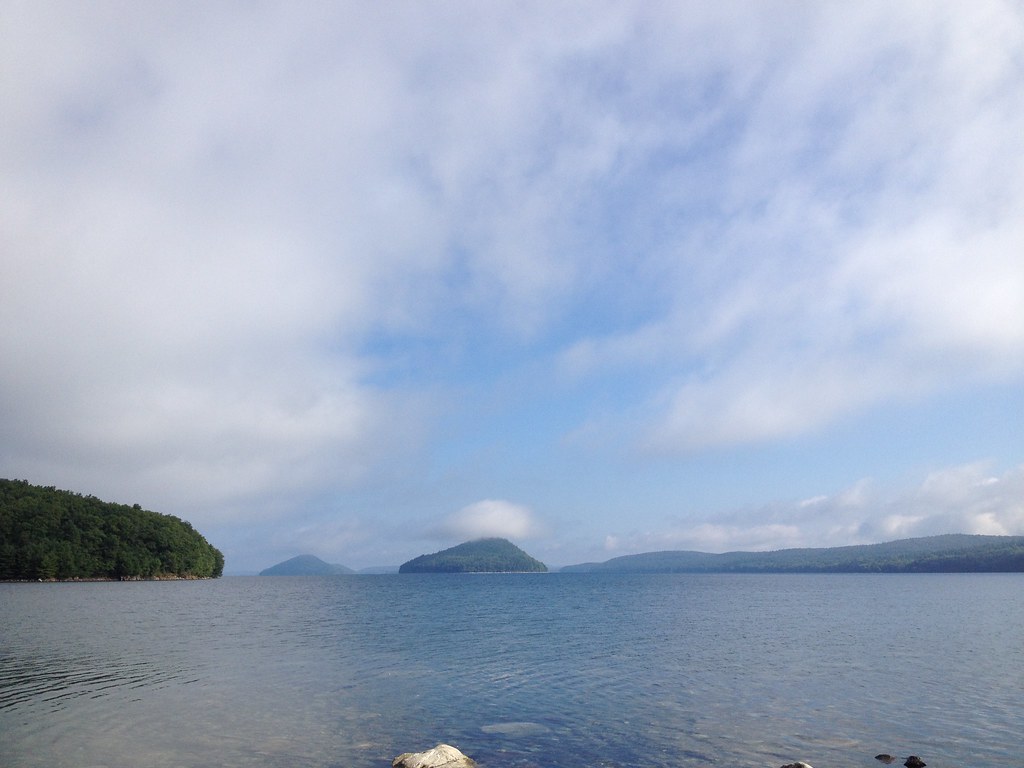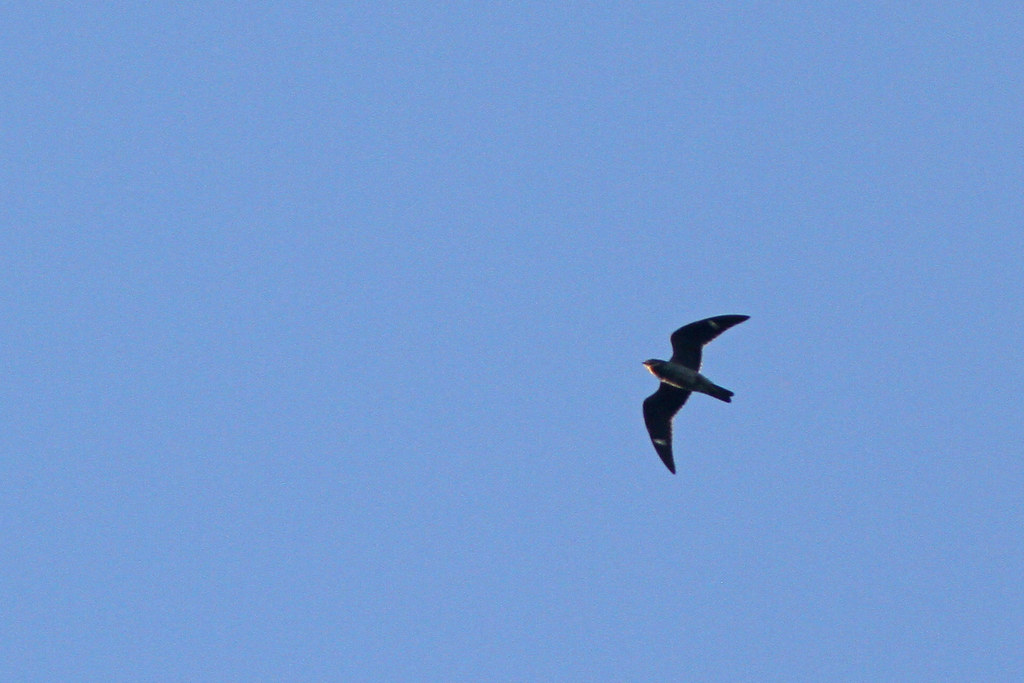 |
| Solitary Sandpiper (R) with Spotted Sandpiper, Connecticut River, Hadley, MA, Sep 1, 2014 |
 |
| East Meadows, Northampton MA, Sep 1, 2014 |
Although we had some decent heavy rain here and some thunder last
night areas to the east got hit harder with storms including a tornado in
Worcester County. Areas to the west and north got less rain and no rain
overnight so the chances of anything being forced down by the rain were quite
low. I got up and going early so I decided to try my luck in turning up a whip
poor will before going in search of shorebirds. I had some luck when I found
one calling before dawn at Covey WMA...getting to be a little late for this
species but not extremely late yet (link to video/audio here: https://www.flickr.com/photos/54277284@N05/14924086289/ I stopped by Winsor Dam but the area was
totally fogged in so I made the command decision to head over to Hadley
again. Unfortunately even the small amount of rain had raised the river level
enough to cover most of the productive mudflats but I still found some
shorebirds nonetheless including a Semipalmated Plover, four Spotted Sandpipers,
four Solitary Sandpipers, a Lesser Yellowlegs and 14 Least Sandpipers plus a Great
Egret. I then headed across the river into the East Meadows where I scanned
many fields but came up empty for shorebirds on the ground. I did have an
interesting peep flyby heading east. It gave an odd grating call and appeared
long winged comparatively but it was tough to pick out plumage details in the
fog. Still trying to figure that one out. Without much luck in the East
Meadows I headed over to the Honeypot but that area was quiet too with just fifty or so Bobolinks and some Indigo Buntings. Not really any puddles to speak of in any of the field complexes despite
the forecast for heavy rain yesterday. I decided to get out of Hadley at this point before
the latest batch of new college students arrived and gummed up the roads.
 |
| Common Mergansers, Quabbin Park, MA, Sep 1, 2014 |
 |
| Looking north toward Shaft 12, Quabbin Park, MA, Sep 1, 2014 |
My
next stop was over to Quabbin Park where I had some decent birds including four
Common Loons, three Common Mergasners, a few shorebirds (including a flyby Killdeer and a Spotted Sandpiper) and an American Woodcock that I flushed out of a tree about four feet off the ground (can't remember flushing this species from a tree before). Also 13 species of warblers including my first
Blackpoll Warbler of the fall plus a Blue winged and Canada Warbler. Also quite
a few Eastern Towhees (nearly twenty) in a relatively small area.
I also managed to see about a dozen Common Nighthawks (all quite high up today) at home this evening making this probably one of the last days this year (at least in Massachusetts) where I will have two nightjar species on the same day (whip poor will and nighthawk). Also a few Chimney Swifts mixed in (but damn tough to get photos of).
 |
| Common Nighthawk, Belchertown, MA, Sep 1, 2014 |
 |
| Common Nighthawk, Belchertown, MA, Sep 1, 2014 |
 |
| Chimney Swift, Belchertown, MA, Sep 1, 2014 |
September 1 also marks a sad anniversary in ornithology as this date 100 years ago is when the last Passenger Pigeon died in a zoo in Ohio thus ending a species that had been the most numerous bird in the North America and perhaps the world with a population estimated around 3-5 billion individuals and making up probably 40% of the entire number of birds flying in North America at one time. Amazing and frightening to think that a species so numerous could be pushed to extinction in such a short time by the actions of man. Here are a couple links to websites with more info on the species as well as an excerpt concerning the species in Massachusetts.
http://passengerpigeon.org/index.html
http://www.audubonmagazine.org/articles/birds/why-passenger-pigeon-went-extinct
The following account concerning the Passenger Pigeon is taken directly from the website: passengerpigeon.org
"MASSACHUSETTS
(Compiled by Joel Greenberg)
Edward Howe Forbush, Birds of Massachusetts and New England (1927), says of its status: “formerly abundant migrant and common local to abundant local summer resident.” He gives the dates of its normal presence within the state as being between March 10 and October 21.
Last Records pf the Passenger Pigeon:
Several reported seen in the early 1890s at Walnut Hill, North Reading, Plymouth, and Woods Hole. The last specimen was shot Melrose on April 12, 1894.
Several reported seen in the early 1890s at Walnut Hill, North Reading, Plymouth, and Woods Hole. The last specimen was shot Melrose on April 12, 1894.
Places Likely Named for Passenger Pigeon:
There are at least 12 places in Massachusetts with pigeon in the name:
There are at least 12 places in Massachusetts with pigeon in the name:
Pigeon Hill (rise) in Bristol County, two in Essex County, one in Middlesex County, one in Norfolk County, and two in Worcester County.
Pigeon Cove (bay) in Essex County.
Pigeon Rock (island) in Essex County.
Pigeon Cove (town) in Essex County.
Pigeon Cove School (school) in Essex County.
Pigeon Hill Cemetery (cemetery) in Worcester County.
Massachusetts highlights:
“Upon the eighth of March from after it was fair daylight, until about eight of the clock in the forenoon, there flew over all the towns in our plantation, so many flocks of doves, each flock containing many thousands and some so many that they obscured the light, that it passeth credit, if but the truth should be written.” Governor Dudley to the Countess of Lincoln, March 12, 1630
The Numbers of those, that visit us in their Seasons, are such, that I am almost afraid of giving you a true Report of them, lest you should imagine a Palephatus were imposing his Incredibles upon you. Cotton Mather in letter to Royal Society of London, 1712.
Saw a pigeon-place on George Heywood’s cleared lot, — the six dead trees set up for the pigeons to alight on, and the brush house close by to conceal the man. I was rather startled to find such a thing going now in Concord. The pigeons on the trees like fabulous birds with their long tails and their pointed breasts. I could hardly believe they were alive and not some wooden birds used for decoys. Henry David Thoreau, September 12, 1851.
“In one of the rural districts of Massachusetts lives a little, weazen-faced, antique man, of remarkable lingual developments. This old man, though near a railroad junction, never set foot in a rail car, or was more than fifty miles from home. It can hardly be wonderful that he is somewhat superstitious. In conversation, recently, relative to a sick neighbor, whose death had been daily and hourly expected, he thus sagely delivered himself: “I don’t believe but what that sick man has pigeon feathers in his bed, for they say whoever sleeps on pigeon feathers never’ll die. There was old Miss –, that lived along several years after the doctors had given her up. For a long time she kept her hand going pit-a-pat on her breast, just like a fluttering pigeon’s wing. When her friends were all tired out tending her, and wondered what made her live on so, a stranger, hearing of the case, came into the house and asked if there was any pigeon feathers around her. Now, her relatives were great hunters and caught swarms of pigeons, and of course they saved the feathers and made use of them, and had a pigeon feather pillow between the upper and under bed. By just pulling out the pillow the old woman dropped quietly away in fifteen minutes. So there must be something salvating in feathers.” Detroit Free Press, 1 April 1863
“Brewster . . . remarks that a heavy flight passed thought eastern Massachusetts between September 2 and September 10, 1871, and that he was assured that thousands were killed and that the netters in Concord and Reading used their nets as of old.” Forbush, 1927.
One morning in 1874 . . . they made their last large catch. With five springs of the nets, “one hundred and dozen and eight Passenger Pigeons were captured.” Every man, woman and child in the Killam and Curtis families set to work plucking the birds for market. They worked all that afternoon and throughout the night, and early the following morning Curtis drove the slow miles to Salem where he sold the catch in the Market Square on Front Street for a dollar and quarter a dozen. Janey Winchell, Old Time New England, v. 45, n. 3, 1955.
Massachusetts Locations Known to Have Passenger Pigeon Skins, Mounts, and or Skeletons:
Amherst: 1) University of Massachusetts; and 2) Amherst College
Boston: 1) *Boston Museum of Science; 2) * Boston’s Children’s Museum
Cambridge: 1) *Harvard Natural History Museum; 2) Museum of Comparative Zoology, Harvard University
Natick: *Natick Natural History Society
Pittsfield: *Berkshire Museum
Salem: Peabody Museum
Springfield: *Springfield Museum (on display occasionally)
Wellesley: *Wellesley College
Worcester: *EcoTarium
* If an asterisk appears, at least one passenger pigeon is known to be on display; this list is mainly based on Hahn's Where is That Vanished Bird (1963). Please let us know of any changes including additional locations and/or birds on display, name changes of institution, if birds are no longer present, etc.
Read Fascinating Historical Accounts of the Passenger Pigeon in Massachusetts
Wisconsin’s A.W. [Bill] Schorger (1884-1972) spent many years researching the history of the Passenger Pigeon, and he summarized his findings in his 1955 book, The Passenger Pigeon: Its Natural History and Extinction. At the time of its publication, the book was the most comprehensive account of the species. Schorger did an excellent job summarizing the nearly 10,000 historical records he discovered in libraries and historical societies around the country, but his original research notes contain many additional details.
For the 2014 centennial, Professor Stanley Temple of the University of Wisconsin-Madison has made all Schorger’s handwritten research notes available in digital form. This link will take you to a table that provides details of all the historical records Bill Schorger discovered for Massachusetts. [Schorger-MA.pdf]
For the 2014 centennial, Professor Stanley Temple of the University of Wisconsin-Madison has made all Schorger’s handwritten research notes available in digital form. This link will take you to a table that provides details of all the historical records Bill Schorger discovered for Massachusetts. [Schorger-MA.pdf]
Read Historical Accounts from Shorger's Original Field Notes about the Passenger Pigeon in Massachusetts
These sources are newly available on the Passenger Pigeon site (as of January 25, 2014). The links below give access to often-firsthand, eyewitness accounts of pigeons, the table includes a cross reference to the exact page in Schorger’s notes where you can read the full text of the account and find a citation of the original source document. All these historical documents are in PDF format in sizes ranging from 24mb - 60mb. These documents will open in their own window. Use the links below to find the page containing the account you’re interested in exploring further:
Schorger pages 1-329
Schorger pages 330-632
Schorger pages 633-959
Schorger pages 960-1242
Schorger pages 1243-1585
Schorger pages 1586-1890
Schorger pages 1891-2232
Schorger pages 2233-2556"
Schorger pages 1-329
Schorger pages 330-632
Schorger pages 633-959
Schorger pages 960-1242
Schorger pages 1243-1585
Schorger pages 1586-1890
Schorger pages 1891-2232
Schorger pages 2233-2556"
No comments:
Post a Comment